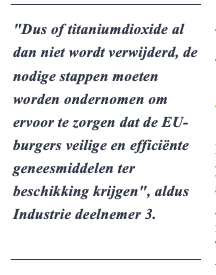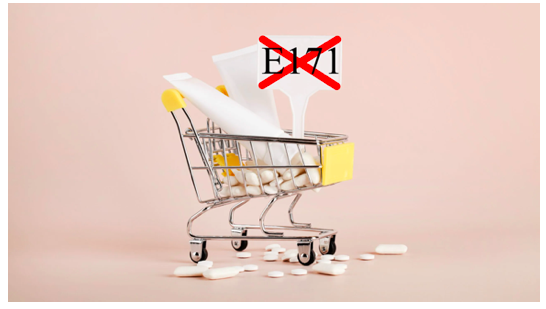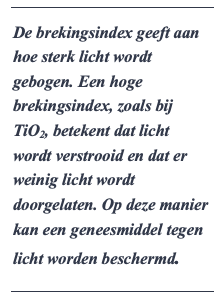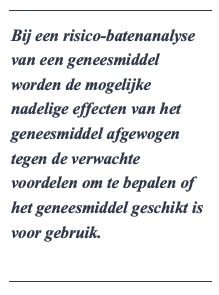TiO2: Schitterend of schadelijk? De mening van belanghebbenden.


Nadat titaniumdioxide (TiO2) in augustus 2022 verboden werd in voeding, overweegt de Europese Unie een verbod op TiO2 als additief ingrediënt in geneesmiddelen en zelfzorgproducten. Een recente studie onderzocht de mogelijke effecten, uitdagingen en noodzakelijke acties met betrekking tot dit voorgestelde verbod.
Waar draait het om?
In een recente studie uitgevoerd door onderzoekers van de KU Leuven, werden perspectieven van verschillende belanghebbenden, waaronderde farmaceutische industrie, academici, beleidsmakers, zorgverleners en patiëntenorganisaties, in kaart gebracht om de gevolgen van een mogelijk TiO2-verbod in geneesmiddelen en zelfzorgproducten te identificeren. De bevindingen van de studie toonden aan dat veiligheid en toxiciteit van TiO2 een complex gegeven zijn, en het vervangen of weglaten van TiO2 in geneesmiddelen uitdagingen met zich mee brengt, zoals stabiliteitsproblemen en problemen met geneesmiddelidentificatie. Bovendien kan een verbod op TiO2 leiden tot tekorten en verschillen in productkwaliteit. Dit wijst erop dat een verbod aanzienlijke negatieve gevolgen zou hebben voor de verschillende belanghebbenden, zoals de patiënt en de farmaceutische industrie.

Waarom TiO2?

TiO2 beschikt over uitzonderlijke eigenschappen, zoals o.a. zijn hoge brekingsindex. Dit is één van de redenen dat het maar liefst 91.000 geregistreerde geneesmiddelen en talloze zelfzorgproducten in de EU wordt gebruikt. De veiligheid van TiO2 is echter het onderwerp van vele discussies. Hoewel het als veilig wordt beschouwd bij dermaal gebruik, tonen studies aan dat inademing ervan toxisch kan zijn. Orale toxiciteit blijft onzeker, hoewel sommige studies suggereren dat deze minimaal of zelfs onbestaande zou zijn.
EU versus de rest van de wereld
Buiten de EU hebben de autoriteiten van landen zoals Canada en de VS geconcludeerd dat het gebruik van TiO2geen gezondheidsrisico vormt. Niettemin zijn de meningen binnen de EU verdeeld over het voorgestelde verbod. Een verbod kan namelijk leiden tot tekorten en onbeschikbaarheid van bepaalde geneesmiddelen. Dit komt onder andere doordat bedrijven ervoor kunnen kiezen om producten niet langer op de markt te brengen in de EU. Bovendien zou het herformuleren van duizenden geneesmiddelen een enorme werklast betekenen voor zowel farmaceutische bedrijven als regelgevende instanties. Gezien de hoeveelheid aan dossiers en schaarsheid aan resources en werkkrachten zou dit kunnen leiden tot een enorme vertraging in deze processen, met alle gevolgen van dien voor de patiënt, die mogelijks geen toegang meer zal hebben tot zijn levensnoodzakelijke therapie.
Balanceren tussen de voor- en nadelen


Bijkomend benadrukte de studie het belang van een grondige risico-batenanalyse die rekening houdt met de voordelen van TiO2 in geneesmiddelen. Verder moet, in het geval van een verbod op TiO2, de enorme werklast voor zowel regelgevers als farmaceutische bedrijven worden erkend en aangepakt. Maar prioritair moet er gestreefd worden naar open, transparante en pragmatische discussies met alle belanghebbenden. Zo kan er uniformiteit in meningen worden gecreëerd en kunnen weloverwogen beslissingen worden genomen die door iedereen worden ondersteund, en waarbij de patiënt centraal staat.
De kracht van communicatie
Een ander cruciaal aspect dat in de studie naar voren kwam, was het belang van communicatie vanuit betrouwbare bronnen. Het vermijden van onnodige onrust onder het publiek en de belanghebbenden is van groot belang. Beschikbaarheid van geneesmiddelen voor patiënten, het leven van de patiënt en de kwaliteit van hun leven waren de belangrijkste prioriteiten voor alle belanghebbenden. Een goede en duidelijke communicatie met patiënten, patiëntenorganisaties en zorgverleners is dan ook essentieel om ervoor te zorgen dat patiënten goed geïnformeerd zijn over de situatie en mogelijke veranderingen in geneesmiddelen, zodat de therapietrouw en identificatie van geneesmiddelen hier niet onder lijden.
Samen sterk

Samenvattend roept de studie op tot een gebalanceerde benadering van het vraagstuk rond TiO2 en het mogelijke verbod in geneesmiddelen en zelfzorgproducten. Het betrekken van alle belanghebbenden bij besluitvorming en het in kaart brengen van risico's, uitdagingen en voordelen zijn cruciaal voor een weloverwogen en effectieve beslissing.
De patiënt centraal
Het is van het allergrootste belang te benadrukken dat elke genomen beslissing een directe impact heeft op de patiënt, met mogelijks verregaande gevolgen gaande tot onbeschikbaarheid van levensnoodzakelijke geneesmiddelen. Daarom is het cruciaal dat patiënten hun belangen centraal staan bij het bepalen van het beleid. Het is noodzakelijk om strategieën te ontwikkelen die niet alleen patiëntveiligheid waarborgen, maar er tevens voor zorgen dat behandelingen toegankelijk blijven.
En wat nu…?
De Europese Commissie zal moeten samenwerken met alle betrokken partijen, waaronder de farmaceutische industrie, regelgevende instanties en patiëntenorganisaties, om weloverwogen beslissingen te nemen over het al dan niet verbieden van TiO2 in geneesmiddelen en zelfzorgproducten. Het is van groot belang dat de gezondheid en het welzijn van de patiënt de hoogste prioriteit blijft, terwijl ook wordt gestreefd naar een beslissing die vanuit wetenschappelijk en praktisch perspectief wordt ondersteund.

Bibliografie
References
-
Racovita AD. Titanium Dioxide: Structure, Impact, and Toxicity. Int J Environ Res Public Health. 2022;19(5681).
-
Fiordaliso F, Bigini P, Salmona M, Diomede L. Toxicological impact of titanium dioxide nanoparticles and food-grade titanium dioxide (E171) on human and environmental health. Environ Sci Nano. 2022 Apr 14;9(4):1199–211.
-
Bischoff NS, de Kok TM, Sijm DTHM, van Breda SG, Briedé JJ, Castenmiller JJM, et al. Review possible adverse effects of food additive e171 (Titanium dioxide) related to particle specific human toxicity, including the immune system. Int J Mol Sci. 2021;22(1):1– 35.
-
The European Commission. Commission Regulation (EU) 2022/63 of 14 January 2022 amending Annexes II and III to Regulation (EC) No 1333/2008 of the European Parliament and of the Council as regards the food additive titanium dioxide (E 171). Official Journal of the European Union. 2022 Jan 14;
-
Peters RJB, Van Bemmel G, Herrera-Rivera Z, Helsper HPFG, Marvin HJP, Weigel S, et al. Characterization of titanium dioxide nanoparticles in food products: Analytical methods to define nanoparticles. J Agric Food Chem. 2014;62(27):6285–93.
-
Shakeel M, Jabeen F, Shabbir S, Asghar MS, Khan MS, Chaudhry AS. Toxicity of Nano-Titanium Dioxide (TiO2-NP) Through Various Routes of Exposure: a Review. Biol Trace Elem Res. 2016;172(1):1–36.
-
Yang Y, Doudrick K, Bi X, Hristovski K, Herckes P, Westerhoff P, et al. Characterization of food-grade titanium dioxide: The presence of nanosized particles. Environ Sci Technol. 2014;48(11):6391–400.
-
Self-care products and Health Canada - Canada.ca [Internet]. [cited 2023 Feb 3]. Available from: https://www.canada.ca/en/health- canada/services/publications/drugs-health-products/self-care-products-and-health-canada-what-you-need-know.html
-
Medical devices made of substances: Opportunities and challenges (hybrid event) | Past | Events | Panel for the Future of Science and Technology (STOA) | European Parliament [Internet]. [cited 2023 Apr 28]. Available from: https://www.europarl.europa.eu/stoa/en/events/details/medical-devices-m…- oppor/20211029WKS03901#:~:text=Substance%2Dbased%20medical%20devices%20are,and%20vaginal%20creams%20and%20to othpaste.
-
The European Parliament and the Council of the European Union. Regulation (EU) 2017/745 of the European Parliament and of the council - of 5 April 2017 - on medical devices, amending Directive 2001/83/ EC, Regulation (EC) No 178/2002 and Regulation (EC) No 1223/2009 and repealing Council Directives 90/385/EEC and 93/42/EEC. Official Journal of the European Union. 2017 May 5;
-
Tobyn M. Overview of TiO2 - Technical review. Brussels; 2022.
-
Hughes K, Baert B. TiO2 food ban in Europe - Regulatory background and current situation elsewhere. Brussels ; 2022.
-
Park W. Negative Refractive Index. Encyclopedia of Materials: Science and Technology. 2010 Jan 1;1–6.
-
Blundell R, Butterworth P, Charlier A, Daurio D, Degenhardt M, Harris D, et al. The Role of Titanium Dioxide (E171) and the Requirements for Replacement Materials in Oral Solid Dosage Forms: An IQ Consortium Working Group Review. J Pharm Sci. 2022;
-
Dréno B, Alexis A, Chuberre B, Marinovich M. Safety of titanium dioxide nanoparticles in cosmetics. Journal of the European Academy of Dermatology and Venereology. 2019;
-
Gupta A, Thakur A. An overview on structural, morphological and optical properties of titanium–dioxide nanoparticles. European Journal of Molecular and Clinical Medicine. 2020;7(7):2815–8.
-
Weir A, Westerhoff P, Fabricius L, Hristovski K, Von Goetz N. Titanium dioxide nanoparticles in food and personal care products. Environ Sci Technol. 2012;46(4):2242–50.
-
Proquin H, Jetten MJ, Jonkhout MCM, Garduño-Balderas LG, Briedé JJ, de Kok TM, et al. Gene expression profiling in colon of mice exposed to food additive titanium dioxide (E171). Food and Chemical Toxicology. 2018;111(October 2017):153–65.
-
The European Commission. Commission Recommendation of 18 October 2011 on the definition of nanomaterial. Official Journal of the European Union [Internet]. 2011 Oct 20 [cited 2023 Jan 27]; Available from: http://ec.europa.eu/health/scientific_committees/emerging/docs/
-
Rompelberg C, Heringa MB, van Donkersgoed G, Drijvers J, Roos A, Westenbrink S, et al. Oral intake of added titanium dioxide and its nanofraction from food products, food supplements and toothpaste by the Dutch population. Nanotoxicology. 2016 Nov 25;10(10):1404–14.
-
Pattan G, Kaul G. Health hazards associated with nanomaterials. Toxicol Ind Health. 2014;30(6):499–519.
-
Sycheva LP, Zhurkov VS, Iurchenko V V., Daugel-Dauge NO, Kovalenko MA, Krivtsova EK, et al. Investigation of genotoxic and cytotoxic effects of micro- and nanosized titanium dioxide in six organs of mice in vivo. Mutat Res Genet Toxicol Environ Mutagen. 2011;726(1):8–14.
-
Bettini S, Boutet-Robinet E, Cartier C, Coméra C, Gaultier E, Dupuy J, et al. Food-grade TiO2 impairs intestinal and systemic immune homeostasis, initiates preneoplastic lesions and promotes aberrant crypt development in the rat colon. Sci Rep. 2017;7:1– 13.
-
Rashid MM, Tavčer PF, Tomšič B. Influence of titanium dioxide nanoparticles on human health and the environment. Nanomaterials. 2021 Sep 1;11(2354).
-
Shakeel M, Jabeen F, Shabbir S, Saleem Asghar M, Saleem Khan M, Chaudhry AS. Toxicity of Nano-Titanium Dioxide (TiO 2-NP) Through Various Routes of Exposure: a Review. 2011;
-
Chilakapati J, Mehendale HM. Acceptable Daily Intake (ADI). Encyclopedia of Toxicology: Third Edition. 2014 Jan 1;8–9.
-
Food additives | EFSA [Internet]. [cited 2023 Mar 12]. Available from: https://www.efsa.europa.eu/en/topics/topic/food-additives
-
About us | EFSA [Internet]. [cited 2022 Dec 23]. Available from: https://www.efsa.europa.eu/en/aboutefsa
-
The European Parliament and The Council of The European Union. Regulation (EC) No 1333/2008 of the European Parliament and of the Council of 16 December 2008 on food additives. Official Journal of the European Union. 2008 Dec 31;
-
Younes M, Aggett P, Aguilar F, Crebelli R, Dusemund B, Filipič M, et al. Evaluation of four new studies on the potential toxicity of titanium dioxide used as a food additive (E 171). EFSA Journal. 2018 Jul 1;16(7).
-
Food safety and quality: Chemical risks and JECFA [Internet]. [cited 2023 Apr 28]. Available from: https://www.fao.org/food/food- safety-quality/scientific-advice/jecfa/en/
-
Titanium Dioxide - Chemical Safety Facts [Internet]. [cited 2022 Dec 23]. Available from: https://www.chemicalsafetyfacts.org/chemicals/titanium-dioxide/
48
-
Official Journal of the European Union. Directive 2009/35/EC of the European Parliament and of the Council of 23 April 2009 on the colouring matters which may be added to medicinal products. Official Journal of the European Union. 2009;
-
Who we are | European Medicines Agency [Internet]. [cited 2022 Dec 23]. Available from: https://www.ema.europa.eu/en/about- us/who-we-are
-
Scientific Committee on Consumer Safety (SCCS) [Internet]. [cited 2022 Dec 23]. Available from: https://health.ec.europa.eu/scientific-committees/scientific-committee-…
-
Bernauer U, Bodin L, Chaudhry Q, Coenraads PJ, Dusinska M, Ezendam J, et al. Scientific Committee on Consumer Safety SCCS Opinion on Titanium dioxide (TiO2) used in cosmetic products that lead to exposure by inhalation [Internet]. 2020. Available from: https://ec.europa.eu/transparency/regexpert/index.cfm
-
Broschard T. Toxicological considerations of TiO2. Brussels ; 2022.
-
Is It Really “FDA Approved”? | FDA [Internet]. [cited 2022 Dec 23]. Available from: https://www.fda.gov/consumers/consumer- updates/it-really-fda-approved
-
The Commission of The European Communities. Commission Regulation (EC) No 1234/2008 of 24 November 2008 concerning the examination of variations to the terms of marketing authorisations for medicinal products for human use and veterinary medicinal products. Official Journal of the European Union. 2008 Dec 12;
-
Tong A, Sainsbury P, Craig J. Consolidated criteria for reporting qualitative research (COREQ): A 32-item checklist for interviews and focus groups. International Journal for Quality in Health Care. 2007 Dec;19(6):349–57.
-
Guest G, Bunce A, Johnson L. How Many Interviews Are Enough?: An Experiment with Data Saturation and Variability. Field methods. 2006;18(1):59–82.
-
Gale NK, Heath G, Cameron E, Rashid S, Redwood S. Using the framework method for the analysis of qualitative data in multi- disciplinary health research. BMC Med Res Methodol. 2013;13(1).
-
Bourka A, Drogkaris P, Agrafiotis I. Pseudonymisation techniques and best practices : recommendations on shaping technology according to data protection and privacy provisions. 2019 Nov;
-
Goldsmith LJ. Using framework analysis in applied qualitative research. Qualitative Report. 2021 Jun 1;26(6):2061–76.
-
Ali I, Suhail M, Alothman ZA, Alwarthan A. Recent advances in syntheses, properties and applications of TiO2 nanostructures. 2018;
-
AESGP, EFPIA, medicines for europe. Use of titanium dioxide as excipient in human medicines - Industry feedback to QWP Experts / EMA Questions. 2021 Jul 2;
-
Herrmann J. The future role of Titanium dioxide as an excipient in pharmaceuticals - The OTC-manufacturers’ perspective. Brussels ; 2022.
-
Hughes K. Titanium dioxide: updates. Chimica Oggi - Chemistry Today . 2022;40:31–3.
-
European Medicines Agency. Final feedback from European Medicine Agency (EMA) to the EU Commission request to evaluate the impact of the removal of titanium dioxide from the list of authorised food additives on medicinal products. 2021.
-
Colorcon. Challenges & opportunities of TiO2 Free Film Coatings. Paris ; 2022.
-
Geneesmiddelen voor menselijk gebruik | Geneesmiddelendatabank [Internet]. [cited 2023 May 7]. Available from: https://geneesmiddelendatabank.be/menselijk-gebruik
-
Pele LC, Thoree V, Bruggraber SFA, Koller D, Thompson RPH, Lomer MC, et al. Pharmaceutical/food grade titanium dioxide particles are absorbed into the bloodstream of human volunteers. Part Fibre Toxicol. 2015 Sep 2;12(1).
-
Papp A, Horváth T, Igaz N, Gopisetty MK, Kiricsi M, Berkesi DS, et al. Presence of Titanium and Toxic Effects Observed in Rat Lungs, Kidneys, and Central Nervous System in vivo and in Cultured Astrocytes in vitro on Exposure by Titanium Dioxide Nanorods. Int J Nanomedicine [Internet]. 2020 Dec 12;15:9939–60. Available from: http://doi.org/10.2147/IJN.S275937
-
Gmoshinski IV, Bagryantseva OV, Khotimchenko SA. Toxicological and hygienic assessment of titanium dioxide nanoparticles as a component of E171 food additive (review of the literature and metahanalysis). Health Risk Analysis. 2019 Jun;(2):145–63.
-
Blevins LK, Crawford RB, Bach A, Rizzo MD, Zhou J, Henriquez JE, et al. Evaluation of immunologic and intestinal effects in rats administered an E 171-containing diet, a food grade titanium dioxide (TiO2). Food and Chemical Toxicology. 2019 Nov 1;133.
-
Yu KN, Sung JH, Lee S, Kim JE, Kim S, Cho WY, et al. Inhalation of titanium dioxide induces endoplasmic reticulum stress-mediated autophagy and inflammation in mice. Food and Chemical Toxicology. 2015 Nov 1;85:106–13.
-
Food additive E171: ANSES reiterates its recommendations for consumer safety | Anses - Agence nationale de sécurité sanitaire de l’alimentation, de l’environnement et du travail [Internet]. [cited 2022 Dec 23]. Available from: https://www.anses.fr/en/content/food- additive-e171-anses-reiterates-its-recommendations-consumer-safety
-
New guide available on classifying and labelling titanium dioxide - ECHA/NR/21/23 [Internet]. 2021 [cited 2023 Jan 1]. Available from: https://echa.europa.eu/-/new-guide-available-on-classifying-and-labelli…
-
Younes M, Aquilina G, Castle L, Engel KH, Fowler P, Frutos Fernandez MJ, et al. Safety assessment of titanium dioxide (E171) as a food additive. EFSA Journal. 2021;19(5).
-
Kirkland D, Aardema MJ, Battersby R v., Beevers C, Burnett K, Burzlaff A, et al. A weight of evidence review of the genotoxicity of titanium dioxide (TiO2). Regulatory Toxicology and Pharmacology. 2022 Oct;105263.
-
Committee on Toxicity. Committee on Toxicity of Chemicals in Food, Consumer Products and the Environment: Interim position paper on titanium dioxide. 2021.
-
Schoneker DR. Why would the EU want to ban titanium dioxide in pharmaceutical products? What would be the potential impact on patients? J Excipients and Food Chem. 2022;13(4):94–8.
-
Review of titanium dioxide as a food additive [Internet]. [cited 2022 Dec 24]. Available from: https://www.foodstandards.gov.au/consumer/foodtech/Pages/Review-of-tita…
-
Belhadj B, Kaabi F. State of the Science of Titanium Dioxide (TiO2) as a Food Additive. 2022.
-
Court of Justice of the European Union. The General Court annuls the Commission Delegated Regulation of 2019 in so far as it concerns the harmonised classification and labelling of titanium dioxide as a carcinogenic substance by inhalation in certain powder forms. 2022 Nov 23;
-
France Appeals EU General Court’s Decision to Annul Titanium Dioxide as Carcinogenic [Internet]. [cited 2023 Mar 10]. Available from: https://www.sgs.com/en/news/2023/02/safeguards-2723-france-appeals-to-a…
-
Audran X. France bans Titanium Dioxide in food products by January 2020. Paris; 2019 Mar.
49
-
ANSES. Opinion of the French Agency for Food, Environmental and Occupational Health & Safety on the risks associated with ingestion of the food additive E171. 2019.
-
The European Parliament and the Council of the European Union. Regulation (EC) No 178/2002 of The European Parliament and of the Council of 28 January 2002 laying down the general principles and requirements of food law, establishing the European Food Safety Authority and laying down procedures in matters of food safety. Official Journal of the European Communities. 2002 Feb 1;
-
Arrêté du 21 décembre 2020 portant suspension de la mise sur le marché des denrées contenant l’additif E 171 (dioxyde de titane - TiO2) - Légifrance [Internet]. [cited 2023 Feb 2]. Available from: https://www.legifrance.gouv.fr/jorf/id/JORFTEXT000042722263
-
Re-evaluation of titanium dioxide (E 171) as a food additive. EFSA Journal [Internet]. 2016 Sep;14(9):e04545. Available from: http://doi.wiley.com/10.2903/j.efsa.2016.4545
-
Guo Z, Martucci NJ, Moreno-Olivas F, Tako E, Mahler GJ. Titanium dioxide nanoparticle ingestion alters nutrient absorption in an in vitro model of the small intestine. NanoImpact. 2017 Jan 1;5:70–82.
-
Heringa MB, Geraets L, van Eijkeren JCH, Vandebriel RJ, de Jong WH, Oomen AG. Risk assessment of titanium dioxide nanoparticles via oral exposure, including toxicokinetic considerations. Nanotoxicology. 2016 Nov 25;10(10):1515–25.
-
EFSA, Bias, and Titanium Dioxide - Pharma Excipients [Internet]. [cited 2023 Apr 8]. Available from: https://www.pharmaexcipients.com/news/efsa-bias-and-titanium-dioxide/
-
The TDMA comments on claims associating titanium dioxide in candies with health risks - TDMA [Internet]. [cited 2023 Apr 8]. Available from: https://www.tdma.info/news/tdma-comments-on-claims-associating-titanium…
-
Code of Federal Regulations - 21CFR73.1575. [cited 2022 Dec 23]; Available from: https://www.accessdata.fda.gov/scripts/cdrh/cfdocs/cfcfr/CFRSearch.cfm?…
-
Schoneker DR. Global Situation with TiO2 (E171) outside of Europe and the UK - Canada, U.S., Australia/New Zealand, Middle East, MERCOSUR, others. Brussels ; 2022.
-
Banned use of titanium dioxide in food production processes in Jordan. Ocean Network Express; 2019.
-
‘Whiter than white’ – titanium dioxide nanoparticles | Focus on food safety [Internet]. [cited 2022 Dec 23]. Available from: https://focusonfoodsafety.wordpress.com/2019/06/04/whiter-than-white-ti…
-
Joint FAO/WHO Expert Committee on Food Additives Ninety-seventh meeting Food Additives List of substances scheduled for evaluation and request for data. 2022 Nov.
-
The European Commission. Commission Delegated Regulation (EU) 2020/217 of 4 October 2019 amending, for the purposes of its adaptation to technical and scientific progress, Regulation (EC) No 1272/2008 of the European Parliament and of the Council on classification, labelling and packaging of substances and mixtures and correcting that Regulation. Official Journal of the European Union [Internet]. 2020 Feb 18; Available from: https://echa.europa.eu/registry-of-clh-intentions-until-outcome/-/disli…- /ecNumber/-/casNumber/-/dte_receiptFrom/-/
-
Titanium dioxide proposed to be classified as suspected of causing cancer when inhaled - ECHA/PR/17/10 [Internet]. 2017 [cited 2023 Jan 1]. Available from: https://echa.europa.eu/-/titanium-dioxide-proposed-to-be-classified-as-…- when-inhaled
-
The General Court of the European Union rules in favour of TDMA Members - TDMA [Internet]. 2022 [cited 2023 Mar 12]. Available from: https://www.tdma.info/news/the-general-court-of-the-european-union-rule…
-
Younes M, Aquilina G, Castle L, Engel KH, Fowler P, Frutos Fernandez MJ, et al. Request for a scientific advice on the safety of Titanium dioxide (TiO2) (CAS/EC numbers 13463-67-7/236-675-5, 1317-70-0/215-280-1, 1317-80-2/215-282-2) in cosmetic products. 2022 Jun 22;(5).
-
Quality of medicines questions and answers: Part 2 | European Medicines Agency [Internet]. [cited 2022 Nov 11]. Available from: https://www.ema.europa.eu/en/human-regulatory/research-development/scie…- answers-part-2#replacement/removal-of-titanium-dioxide-(tio2)-in-medicines.-technical-and-procedural-guidance.-new-july-2022- section
-
Lumbreras B, López-Pintor E. Impact of changes in pill appearance in the adherence to angiotensin receptor blockers and in the blood pressure levels: A retrospective cohort study. BMJ Open. 2017;7(3):1–10.
-
Altmann A, Faget S, Misselwitz S, Muehlenfeld C, Ramtin A, Teckoe J, et al. Technical challenges substituting TiO2 from different coating producers’ point of view. Brussels; 2022.
-
New Questions and Answers from the EMA regarding Titanium Dioxide in Medicines - ECA Academy [Internet]. [cited 2022 Oct 15]. Available from: https://www.gmp-compliance.org/gmp-news/new-questions-and-answers-from-…- medicines
-
The European Commission. Commission Regulation (EU) No 231/2012 of 9 March 2012 laying down specifications for food additives listed in Annexes II and III to Regulation (EC) No 1333/2008 of the European Parliament and of the Council. Official Journal of the European Union. 2012 Nov 29;
-
Lonza. Challenges from a capsule shell producer point of view. Brussels ; 2022.
-
The European Commission. Guidelines of 16.5.2013 on the details of the various categories of variations, on the operation of the procedures laid down in Chapters II, IIa, III and IV of Commission Regulation (EC) No 1234/2008 of 24 November 2008 concerning the examination of variations to the terms of marketing authorisations for medicinal products for human use and veterinary medicinal products and on the documentation to be submitted pursuant to those procedures. 2013 May 16;
-
Hughes K, Melnick J, R. Schoneker D, Yunis M, Weidner M, Broschard Thomas. The future Role of Titanium dioxide as an excipient in Pharmaceuticals - Exploring the current and future situation worldwide. 2022;
-
Burgoon LD. What do 681 Drug Tablets and 4,080 Skittles Have in Common? - The Toxic Truth Blog [Internet]. 2022 [cited 2023 Apr 8]. Available from: https://toxictruthblog.com/what-do-681-drug-tablets-and-4080-skittles-h…
-
4,080 Skittles per Day, DNA Damage and the Law - The Toxic Truth Blog [Internet]. [cited 2023 Apr 8]. Available from: https://toxictruthblog.com/4080-skittles-per-day-dna-damage-and-the-law/
-
The European Commission. Proposal for a Directive of the European Parliament and of the Council on the Union code relating to medicinal products for human use, and repealing Directive 2001/83/EC and Directive 2009/35/EC. 2023 Apr 26; Available from: https://health.ec.europa.eu/medicinal-products/pharmaceutical-strategy-….













